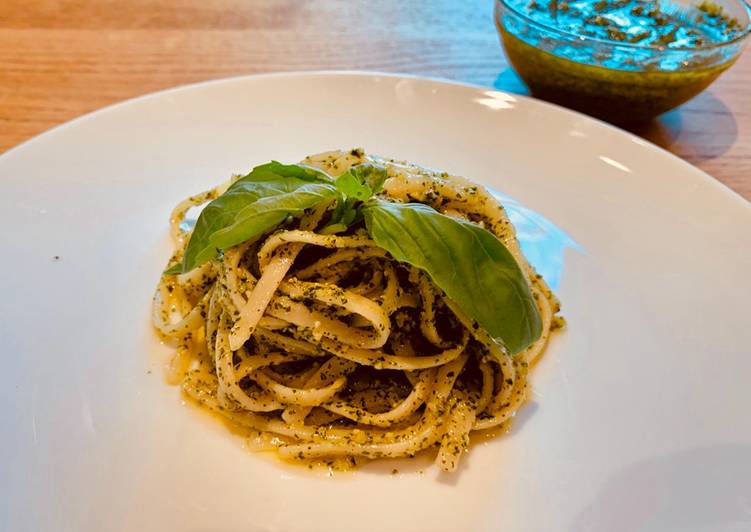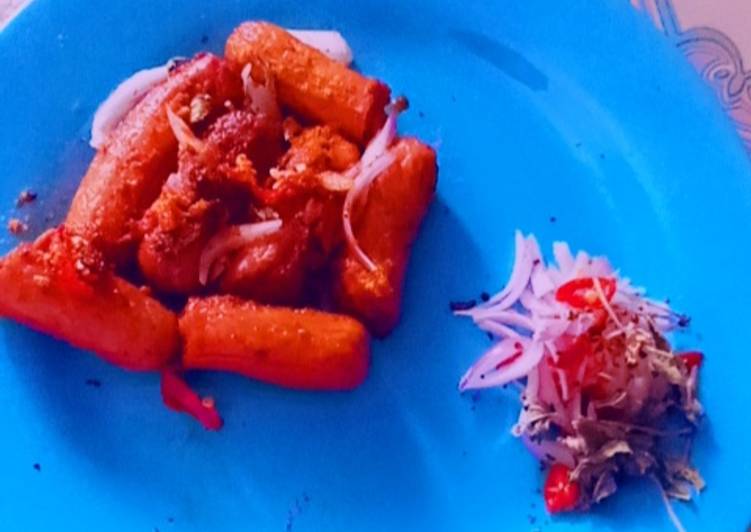
Hello everybody, hope you’re having an amazing day today. Today, I’m gonna show you how to make a distinctive dish, classic pesto pasta. One of my favorites. This time, I’m gonna make it a little bit unique. This will be really delicious.
Classic pesto just like it's name. I have to admit that we are not a huge fans of pesto pasta in our family but we do like basil and plant some every year with the seeds from the previous years plants. The secret to making pesto into a great pasta dressing is to get the sauce to the right consistency. Fresh from the food processor, pestos are usually too thick to coat pastas; you'll just end up with mounds of the sauce amid a lot of undressed noodles. • Pasta, Rice or Couscous: Toss with hot cooked pasta, rice or couscous. • Pasta Salads: Replace a little of the mayonnaise or dressing with pesto in pasta salads. • Spread on crust instead of using traditional pizza sauce or add dollops to baked pizza as a topping.
Classic Pesto Pasta is one of the most popular of current trending foods in the world. It’s appreciated by millions every day. It’s easy, it is fast, it tastes yummy. Classic Pesto Pasta is something that I have loved my entire life. They’re nice and they look fantastic.
To get started with this particular recipe, we must prepare a few components. You can cook classic pesto pasta using 6 ingredients and 5 steps. Here is how you can achieve it.
The ingredients needed to make Classic Pesto Pasta:
- Get 100 g spaghetti
- Take 50 g pine nuts
- Take 50 g grated Parmesan cheese (or vegan alternative)
- Make ready 80 g (or a large handful) fresh basil
- Make ready 100-150 mls olive oil
- Make ready 2 cloves garlic
Add the basil, Parmesan, pine nuts and garlic to a food processor. Pulse a few times to break up the garlic and nuts. The pesto that most of the world knows as the one-and-only "pesto" is, in fact, just one of endless kinds."Pesto" means "pounded," from the verb pestare ("to pound"), because the old-fashioned way to make pesto (and the one that many cooks still swear by) is to pound the ingredients – a mixture of aromatic herbs, salt, garlic, olive oil, cheese, and sometimes nuts – with a mortar and pestle. I made this according to instructions, and while a good basic pesto pasta recipe, there was something missing.
Steps to make Classic Pesto Pasta:
- Prepare your ingredients before starting, begin by gathering everything you need.
- Remove the skin of your garlic cloves, and crush with a garlic press. Chop the garlic finely with a knife if you don’t have a press. Add the chopped garlic to your food processor.
- Remove the thick stems from your basil and discard, place the washed leaves into the food processor. Add the pine nuts, 100 mls of the oil and the parmesan too.
- Blend the mixture, you may need to scrape down the sides of the blender several times to get all of the ingredients incorporated fully. If it’s too thick, add more olive oil.
- That’s it! Set your sauce to one side while you cook your pasta according the pasta manufacturers instructions. Then mix the spaghetti with a couple of tbsp of pesto. Top with a few more pine nuts and serve.
The pesto that most of the world knows as the one-and-only "pesto" is, in fact, just one of endless kinds."Pesto" means "pounded," from the verb pestare ("to pound"), because the old-fashioned way to make pesto (and the one that many cooks still swear by) is to pound the ingredients – a mixture of aromatic herbs, salt, garlic, olive oil, cheese, and sometimes nuts – with a mortar and pestle. I made this according to instructions, and while a good basic pesto pasta recipe, there was something missing. I then added the pasta to the pan and mixed well, serving right out of the frying pan. Some say using a blender rather than a food processor results in a smoother puree. When combining pesto with pasta, Ligurians mix a small ladle of the cooking water into the pesto just before.
So that is going to wrap this up for this special food classic pesto pasta recipe. Thank you very much for reading. I’m confident you can make this at home. There’s gonna be interesting food at home recipes coming up. Don’t forget to save this page on your browser, and share it to your family, friends and colleague. Thanks again for reading. Go on get cooking!

